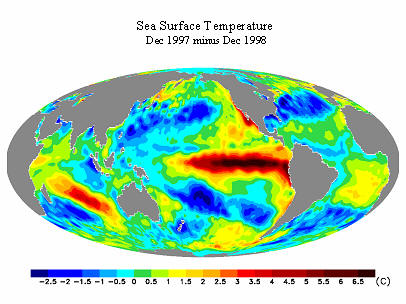Professor James Carton is leading research efforts on oceanographic use of remote sensing data. Observing the changing climate of the ocean presents a daunting observational challenge. One of the most exciting developments in climate research in recent years has been the introduction of satellite remote sensing observations to ocean studies. The ocean is a conducting medium and thus electromagnetic sensors are constrained to observe surface properties including: infrared and microwave emission (sea surface temperature), laser and microwave ranging (sea level), microwave reflectance (wave heights and surface wind stress), and brighness in the visible bands (phytoplankton concentration). Some of these surface observations allow us to infer subsurface properties of the ocean. For example, in the tropics, increases in sea level coincide with a deepening of the warm upper layer of the ocean (a 1cm rise roughly corresponds to a 2m deepening). In the very near future, satellite-based observations of time-dependent gravity will allow an additional direct measurement of the horizontal redistribution of mass. Scientists within the Department involved in research projects examining all of these data types include Drs. Carton, Murtugudde, Wajsowicz, and Chepurin.
Professor Antonio Busalacchi, Director of ESSIC, is leading research on climate variability and the role of tropical ocean circulation in the coupled climate system. Climatic events such as the El Niño/Southern Oscillation (ENSO) disrupt the normal seasonal cycle, hand demonstrate that climate can vary dramatically from year to year and significantly affect society. Over the past two decades, research has demonstrated that ENSO is an intrinsic oscillation of the coupled ocean-atmosphere system. Therefore, there is a need for better understanding of the coupled climate system, its natural variability, and predicting the physical processes responsible for climate variability and predictability on seasonal, interannual, decadal, and centennial time scales. Key components of his research focusing on the role of the coupled ocean and atmosphere within the overall climate system (with emphasis on ocean variability) on seasonal to centennial time scales. Selected bibliography.
 |
 |
Sea Surface Temperature (SST) and sea level impact of the 97-98 ENSO.

